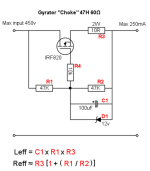Hi,
I've put a generic gyrator diagram in LTSpice. This should simulate a choke with 47H and 60 Ohm.
The reason for this is that I want to "see" how much an AC signal on top of the DC is filtered by the gyrator. The input is 600 VDC with 0.5 Volt AC and a load (R4) of 500 mA.
I would like to use the probe in LTSpice to check all points of the diagram for voltages, currents, etc., but when I click RUN I get a list with parameters.
There is no parameter for the output AC voltage in this parameter list, so I still cannot check if it works.
I attach my .asc file and I hope someone with better LTSpice knowledge can make the proper adjustments to get this running.
Regards, Gerrit
I've put a generic gyrator diagram in LTSpice. This should simulate a choke with 47H and 60 Ohm.
The reason for this is that I want to "see" how much an AC signal on top of the DC is filtered by the gyrator. The input is 600 VDC with 0.5 Volt AC and a load (R4) of 500 mA.
I would like to use the probe in LTSpice to check all points of the diagram for voltages, currents, etc., but when I click RUN I get a list with parameters.
There is no parameter for the output AC voltage in this parameter list, so I still cannot check if it works.
I attach my .asc file and I hope someone with better LTSpice knowledge can make the proper adjustments to get this running.
Regards, Gerrit
Attachments
Hi Elvee,
Thanks for your help. I based my diagram on the diagram below. Unfortunately I don't know where it comes from.
As you can see the capacitor is not connected to ground (as with a capacitor multiplier).
I don't quite understand the two options you offer for this circuit:
a. capacitor to ground (capacitor multiplier?)
b. make the MOS operate as a gyrator (how?)
Regards, Gerrit
Thanks for your help. I based my diagram on the diagram below. Unfortunately I don't know where it comes from.
As you can see the capacitor is not connected to ground (as with a capacitor multiplier).
I don't quite understand the two options you offer for this circuit:
a. capacitor to ground (capacitor multiplier?)
b. make the MOS operate as a gyrator (how?)
Regards, Gerrit
Attachments
a connect the negative side of the capacitor to GND
b it is configured as a gyrator, but it doesn' work well because of the MOS: it has a lambda unsuitable for such an application. With another type, it works a little better:

b it is configured as a gyrator, but it doesn' work well because of the MOS: it has a lambda unsuitable for such an application. With another type, it works a little better:
Hi Elvee,
What is the lambda of a MOSFET. Looking in the specifications I cannot find this word.
What should I look for (which parameter) and which value is better?
Regard, Gerrit
What is the lambda of a MOSFET. Looking in the specifications I cannot find this word.
What should I look for (which parameter) and which value is better?
Regard, Gerrit
The lambda parameter rarely appears in the datasheet. It is stated explicitly in the spice model (when it is accurate), or it can be inferred from curves in the datasheet showing the variation of Id wrt to Vds: the more horizontal the curve is, the better.
Here I have altered the lambda parameter of the STP8NM60, from 0.005 to 0.0005 ; you can see a great performance improvement:

Here I have altered the lambda parameter of the STP8NM60, from 0.005 to 0.0005 ; you can see a great performance improvement:
Attachments
I had a play with e-chokes last year ( https://www.diyaudio.com/community/threads/e-choke-performance-testing.406704/ ).
Some references include:
1993 Strict WW September
2006 Quinn http://www.aquinaudio.co.uk/act_choke.html
Merlin's power supply book
Some references include:
1993 Strict WW September
2006 Quinn http://www.aquinaudio.co.uk/act_choke.html
Merlin's power supply book
- Home
- Amplifiers
- Power Supplies
- MosFET gyrator in LTSpice
